Impact of COVID-19 and Recommendations for Tesco's Retail Strategy
VerifiedAdded on 2023/01/07
|8
|2601
|22
Report
AI Summary
This report provides a comprehensive analysis of Tesco within the retail industry. It begins with an introduction to the retail sector, defining its core functions and highlighting Tesco's position as a major player. The main body of the report delves into an in-depth analysis of Tesco's internal environment using a SWOT analysis, identifying its strengths, weaknesses, opportunities, and threats. It then explores current trends in the retail industry, particularly the impact of COVID-19, including demand fluctuations, changes in payment processes, increased focus on safety, and the rise of online sales. The report concludes with specific recommendations for Tesco to navigate these challenges and capitalize on emerging opportunities, such as managing demand, adapting to social distancing norms, and enhancing online sales strategies, all aimed at ensuring Tesco's continued success and market share in the evolving retail landscape.
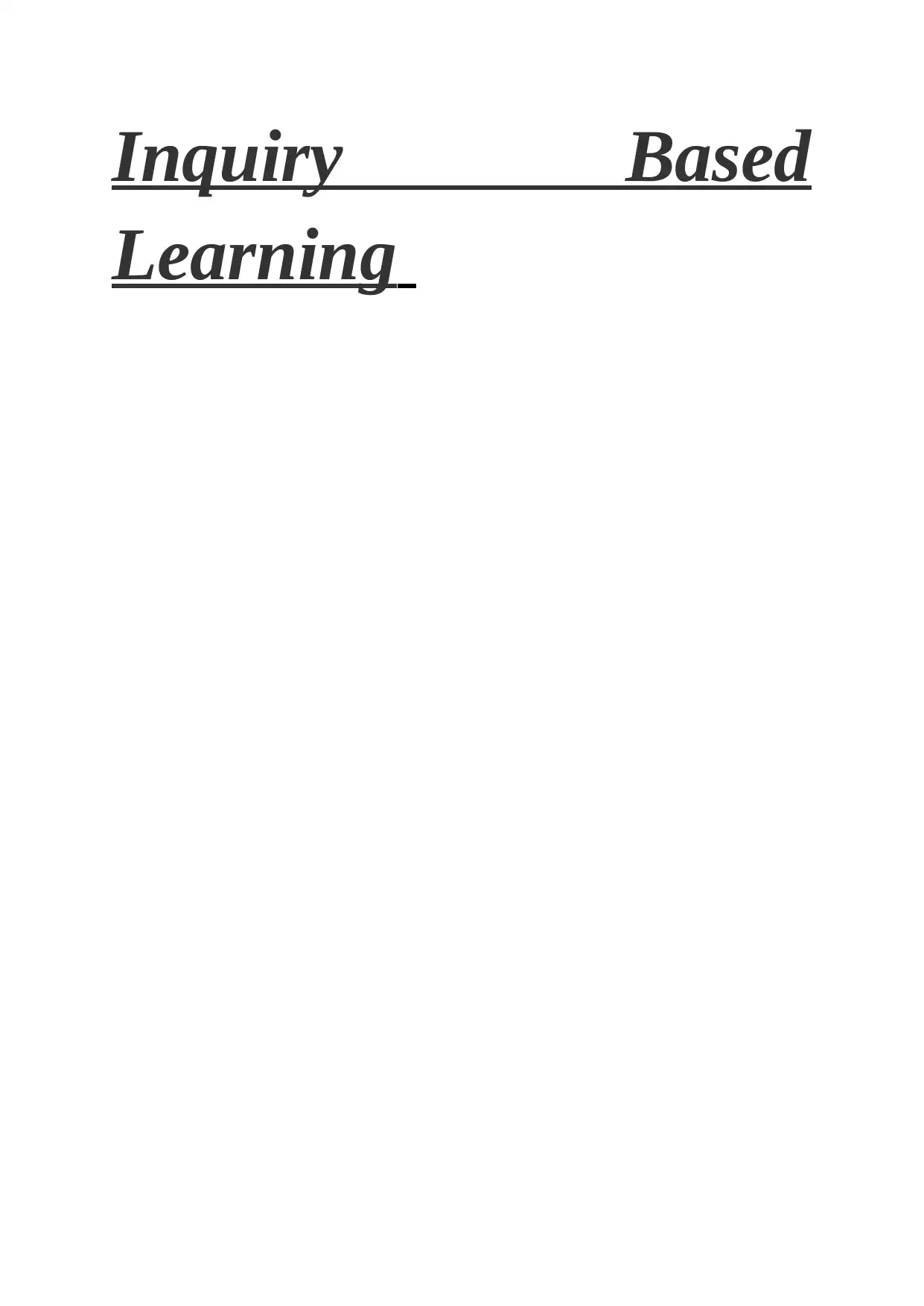
Inquiry Based
Learning
Learning
Paraphrase This Document
Need a fresh take? Get an instant paraphrase of this document with our AI Paraphraser
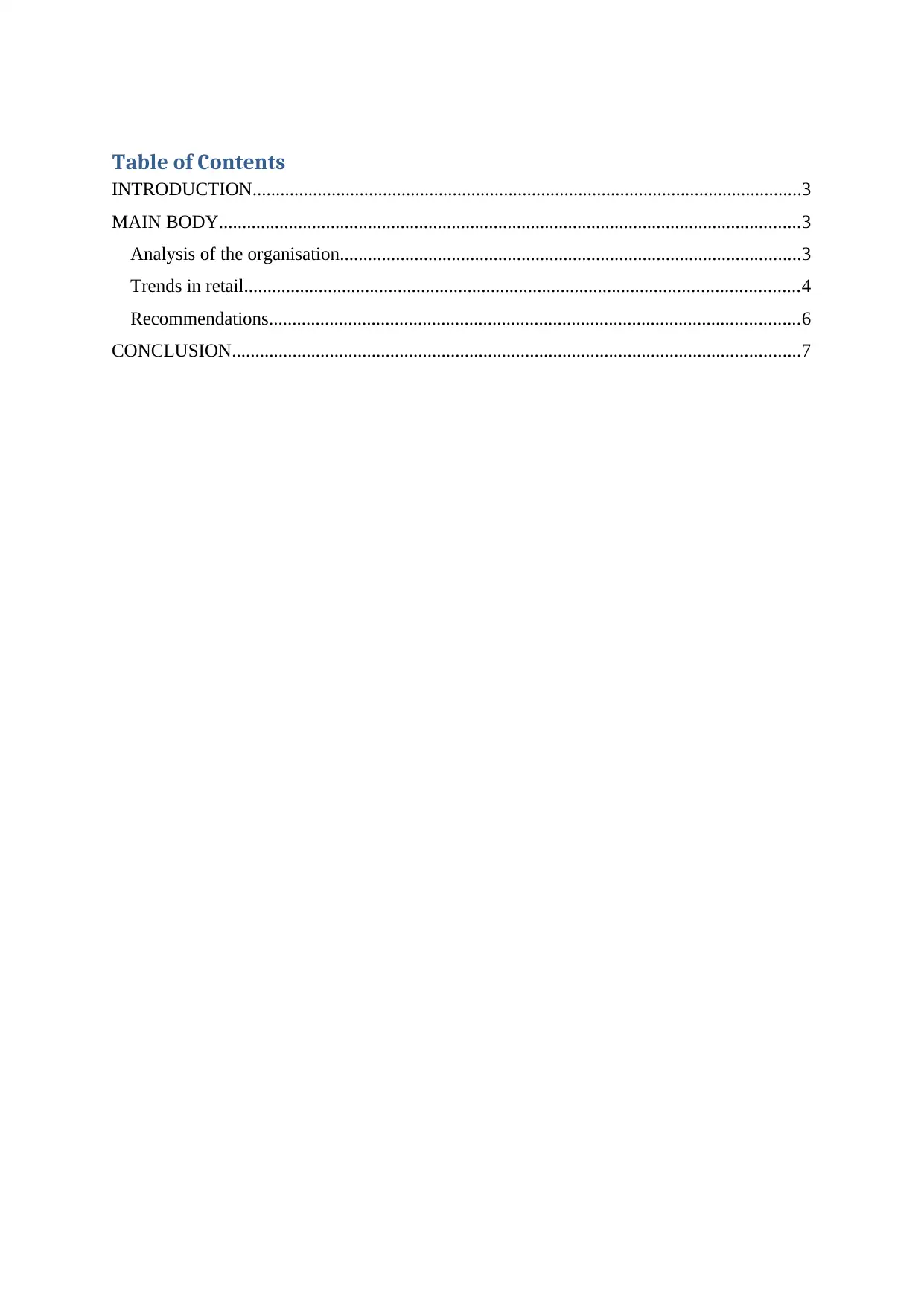
Table of Contents
INTRODUCTION......................................................................................................................3
MAIN BODY.............................................................................................................................3
Analysis of the organisation...................................................................................................3
Trends in retail.......................................................................................................................4
Recommendations..................................................................................................................6
CONCLUSION..........................................................................................................................7
INTRODUCTION......................................................................................................................3
MAIN BODY.............................................................................................................................3
Analysis of the organisation...................................................................................................3
Trends in retail.......................................................................................................................4
Recommendations..................................................................................................................6
CONCLUSION..........................................................................................................................7
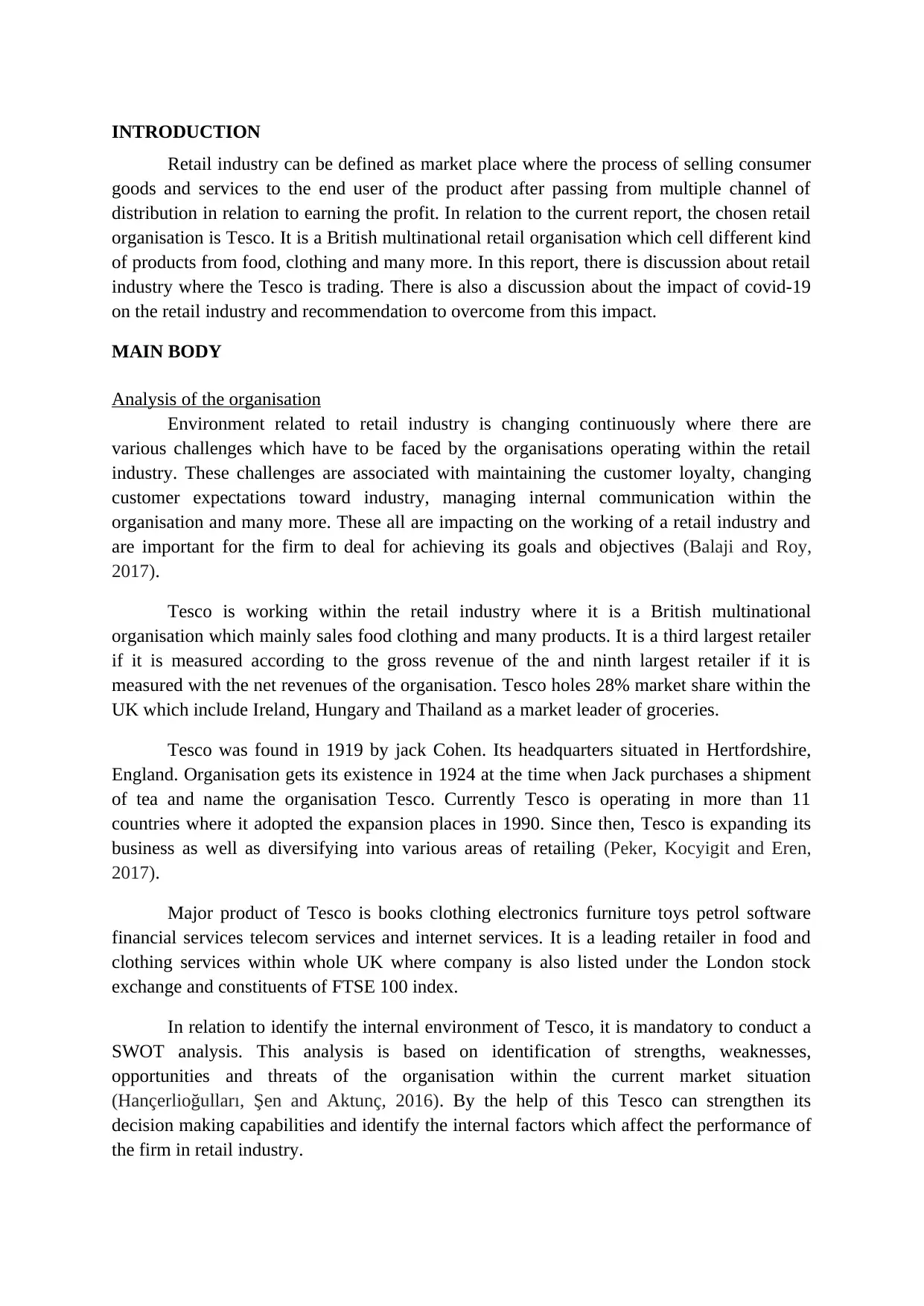
INTRODUCTION
Retail industry can be defined as market place where the process of selling consumer
goods and services to the end user of the product after passing from multiple channel of
distribution in relation to earning the profit. In relation to the current report, the chosen retail
organisation is Tesco. It is a British multinational retail organisation which cell different kind
of products from food, clothing and many more. In this report, there is discussion about retail
industry where the Tesco is trading. There is also a discussion about the impact of covid-19
on the retail industry and recommendation to overcome from this impact.
MAIN BODY
Analysis of the organisation
Environment related to retail industry is changing continuously where there are
various challenges which have to be faced by the organisations operating within the retail
industry. These challenges are associated with maintaining the customer loyalty, changing
customer expectations toward industry, managing internal communication within the
organisation and many more. These all are impacting on the working of a retail industry and
are important for the firm to deal for achieving its goals and objectives (Balaji and Roy,
2017).
Tesco is working within the retail industry where it is a British multinational
organisation which mainly sales food clothing and many products. It is a third largest retailer
if it is measured according to the gross revenue of the and ninth largest retailer if it is
measured with the net revenues of the organisation. Tesco holes 28% market share within the
UK which include Ireland, Hungary and Thailand as a market leader of groceries.
Tesco was found in 1919 by jack Cohen. Its headquarters situated in Hertfordshire,
England. Organisation gets its existence in 1924 at the time when Jack purchases a shipment
of tea and name the organisation Tesco. Currently Tesco is operating in more than 11
countries where it adopted the expansion places in 1990. Since then, Tesco is expanding its
business as well as diversifying into various areas of retailing (Peker, Kocyigit and Eren,
2017).
Major product of Tesco is books clothing electronics furniture toys petrol software
financial services telecom services and internet services. It is a leading retailer in food and
clothing services within whole UK where company is also listed under the London stock
exchange and constituents of FTSE 100 index.
In relation to identify the internal environment of Tesco, it is mandatory to conduct a
SWOT analysis. This analysis is based on identification of strengths, weaknesses,
opportunities and threats of the organisation within the current market situation
(Hançerlioğulları, Şen and Aktunç, 2016). By the help of this Tesco can strengthen its
decision making capabilities and identify the internal factors which affect the performance of
the firm in retail industry.
Retail industry can be defined as market place where the process of selling consumer
goods and services to the end user of the product after passing from multiple channel of
distribution in relation to earning the profit. In relation to the current report, the chosen retail
organisation is Tesco. It is a British multinational retail organisation which cell different kind
of products from food, clothing and many more. In this report, there is discussion about retail
industry where the Tesco is trading. There is also a discussion about the impact of covid-19
on the retail industry and recommendation to overcome from this impact.
MAIN BODY
Analysis of the organisation
Environment related to retail industry is changing continuously where there are
various challenges which have to be faced by the organisations operating within the retail
industry. These challenges are associated with maintaining the customer loyalty, changing
customer expectations toward industry, managing internal communication within the
organisation and many more. These all are impacting on the working of a retail industry and
are important for the firm to deal for achieving its goals and objectives (Balaji and Roy,
2017).
Tesco is working within the retail industry where it is a British multinational
organisation which mainly sales food clothing and many products. It is a third largest retailer
if it is measured according to the gross revenue of the and ninth largest retailer if it is
measured with the net revenues of the organisation. Tesco holes 28% market share within the
UK which include Ireland, Hungary and Thailand as a market leader of groceries.
Tesco was found in 1919 by jack Cohen. Its headquarters situated in Hertfordshire,
England. Organisation gets its existence in 1924 at the time when Jack purchases a shipment
of tea and name the organisation Tesco. Currently Tesco is operating in more than 11
countries where it adopted the expansion places in 1990. Since then, Tesco is expanding its
business as well as diversifying into various areas of retailing (Peker, Kocyigit and Eren,
2017).
Major product of Tesco is books clothing electronics furniture toys petrol software
financial services telecom services and internet services. It is a leading retailer in food and
clothing services within whole UK where company is also listed under the London stock
exchange and constituents of FTSE 100 index.
In relation to identify the internal environment of Tesco, it is mandatory to conduct a
SWOT analysis. This analysis is based on identification of strengths, weaknesses,
opportunities and threats of the organisation within the current market situation
(Hançerlioğulları, Şen and Aktunç, 2016). By the help of this Tesco can strengthen its
decision making capabilities and identify the internal factors which affect the performance of
the firm in retail industry.
⊘ This is a preview!⊘
Do you want full access?
Subscribe today to unlock all pages.

Trusted by 1+ million students worldwide
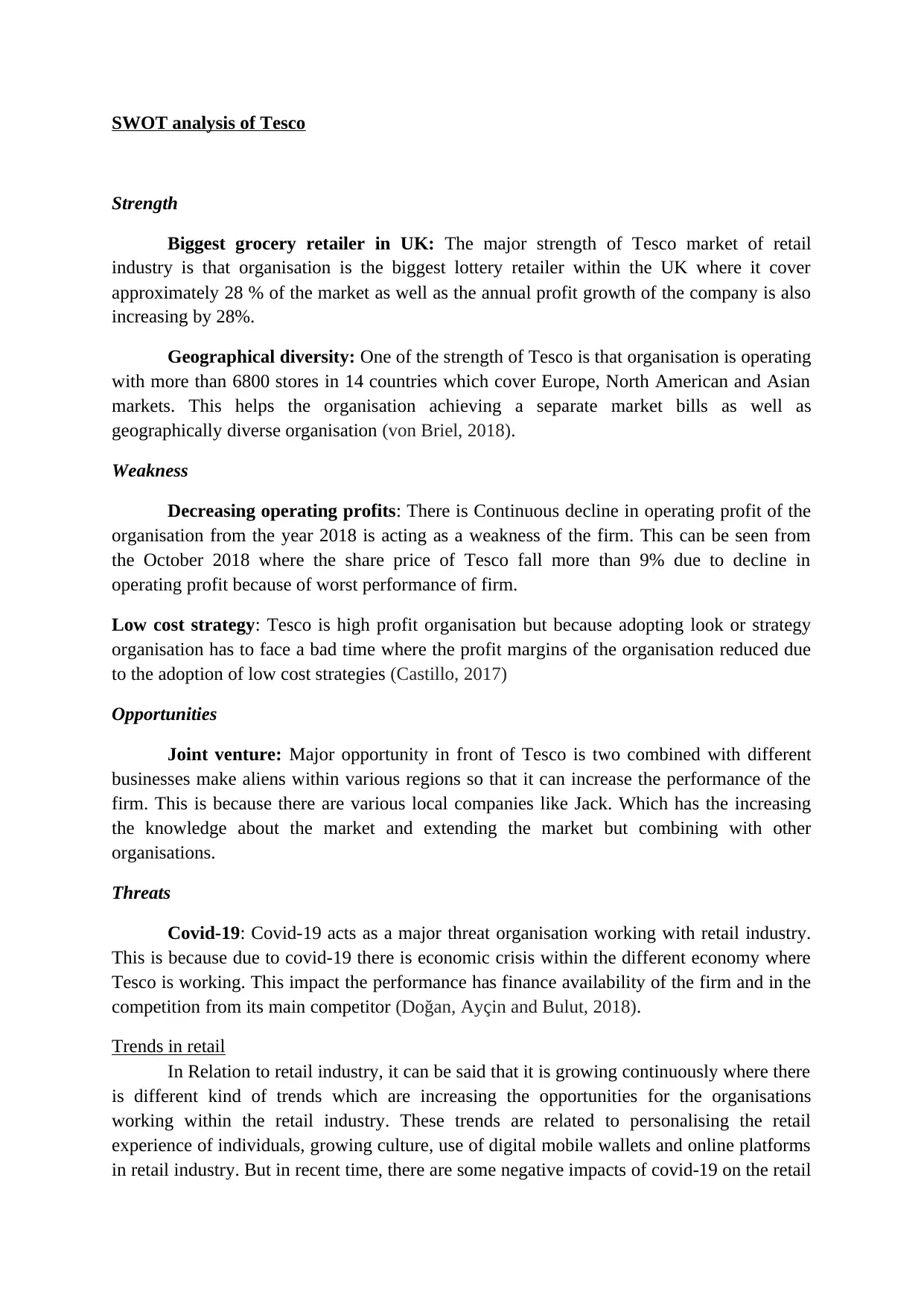
SWOT analysis of Tesco
Strength
Biggest grocery retailer in UK: The major strength of Tesco market of retail
industry is that organisation is the biggest lottery retailer within the UK where it cover
approximately 28 % of the market as well as the annual profit growth of the company is also
increasing by 28%.
Geographical diversity: One of the strength of Tesco is that organisation is operating
with more than 6800 stores in 14 countries which cover Europe, North American and Asian
markets. This helps the organisation achieving a separate market bills as well as
geographically diverse organisation (von Briel, 2018).
Weakness
Decreasing operating profits: There is Continuous decline in operating profit of the
organisation from the year 2018 is acting as a weakness of the firm. This can be seen from
the October 2018 where the share price of Tesco fall more than 9% due to decline in
operating profit because of worst performance of firm.
Low cost strategy: Tesco is high profit organisation but because adopting look or strategy
organisation has to face a bad time where the profit margins of the organisation reduced due
to the adoption of low cost strategies (Castillo, 2017)
Opportunities
Joint venture: Major opportunity in front of Tesco is two combined with different
businesses make aliens within various regions so that it can increase the performance of the
firm. This is because there are various local companies like Jack. Which has the increasing
the knowledge about the market and extending the market but combining with other
organisations.
Threats
Covid-19: Covid-19 acts as a major threat organisation working with retail industry.
This is because due to covid-19 there is economic crisis within the different economy where
Tesco is working. This impact the performance has finance availability of the firm and in the
competition from its main competitor (Doğan, Ayçin and Bulut, 2018).
Trends in retail
In Relation to retail industry, it can be said that it is growing continuously where there
is different kind of trends which are increasing the opportunities for the organisations
working within the retail industry. These trends are related to personalising the retail
experience of individuals, growing culture, use of digital mobile wallets and online platforms
in retail industry. But in recent time, there are some negative impacts of covid-19 on the retail
Strength
Biggest grocery retailer in UK: The major strength of Tesco market of retail
industry is that organisation is the biggest lottery retailer within the UK where it cover
approximately 28 % of the market as well as the annual profit growth of the company is also
increasing by 28%.
Geographical diversity: One of the strength of Tesco is that organisation is operating
with more than 6800 stores in 14 countries which cover Europe, North American and Asian
markets. This helps the organisation achieving a separate market bills as well as
geographically diverse organisation (von Briel, 2018).
Weakness
Decreasing operating profits: There is Continuous decline in operating profit of the
organisation from the year 2018 is acting as a weakness of the firm. This can be seen from
the October 2018 where the share price of Tesco fall more than 9% due to decline in
operating profit because of worst performance of firm.
Low cost strategy: Tesco is high profit organisation but because adopting look or strategy
organisation has to face a bad time where the profit margins of the organisation reduced due
to the adoption of low cost strategies (Castillo, 2017)
Opportunities
Joint venture: Major opportunity in front of Tesco is two combined with different
businesses make aliens within various regions so that it can increase the performance of the
firm. This is because there are various local companies like Jack. Which has the increasing
the knowledge about the market and extending the market but combining with other
organisations.
Threats
Covid-19: Covid-19 acts as a major threat organisation working with retail industry.
This is because due to covid-19 there is economic crisis within the different economy where
Tesco is working. This impact the performance has finance availability of the firm and in the
competition from its main competitor (Doğan, Ayçin and Bulut, 2018).
Trends in retail
In Relation to retail industry, it can be said that it is growing continuously where there
is different kind of trends which are increasing the opportunities for the organisations
working within the retail industry. These trends are related to personalising the retail
experience of individuals, growing culture, use of digital mobile wallets and online platforms
in retail industry. But in recent time, there are some negative impacts of covid-19 on the retail
Paraphrase This Document
Need a fresh take? Get an instant paraphrase of this document with our AI Paraphraser
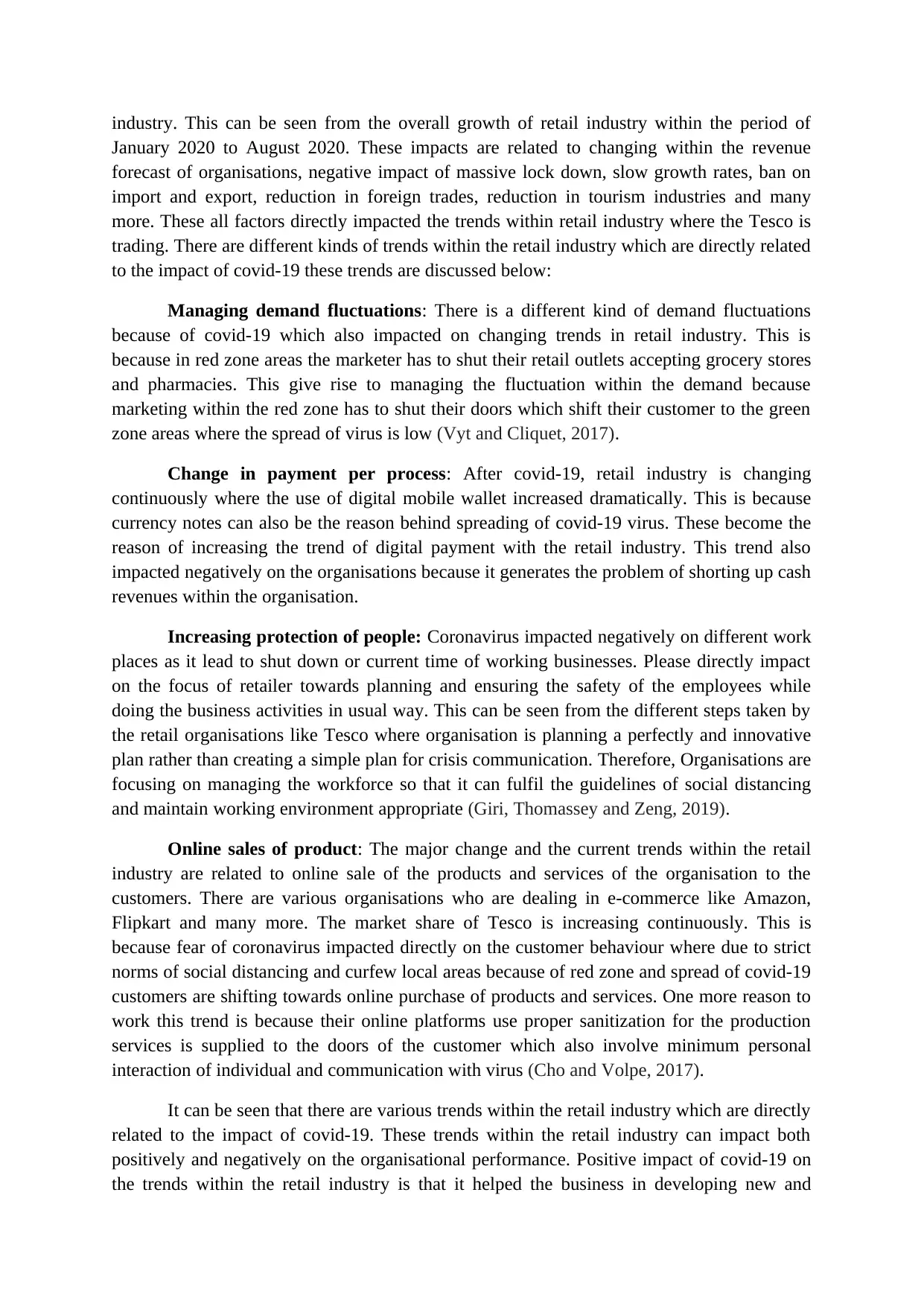
industry. This can be seen from the overall growth of retail industry within the period of
January 2020 to August 2020. These impacts are related to changing within the revenue
forecast of organisations, negative impact of massive lock down, slow growth rates, ban on
import and export, reduction in foreign trades, reduction in tourism industries and many
more. These all factors directly impacted the trends within retail industry where the Tesco is
trading. There are different kinds of trends within the retail industry which are directly related
to the impact of covid-19 these trends are discussed below:
Managing demand fluctuations: There is a different kind of demand fluctuations
because of covid-19 which also impacted on changing trends in retail industry. This is
because in red zone areas the marketer has to shut their retail outlets accepting grocery stores
and pharmacies. This give rise to managing the fluctuation within the demand because
marketing within the red zone has to shut their doors which shift their customer to the green
zone areas where the spread of virus is low (Vyt and Cliquet, 2017).
Change in payment per process: After covid-19, retail industry is changing
continuously where the use of digital mobile wallet increased dramatically. This is because
currency notes can also be the reason behind spreading of covid-19 virus. These become the
reason of increasing the trend of digital payment with the retail industry. This trend also
impacted negatively on the organisations because it generates the problem of shorting up cash
revenues within the organisation.
Increasing protection of people: Coronavirus impacted negatively on different work
places as it lead to shut down or current time of working businesses. Please directly impact
on the focus of retailer towards planning and ensuring the safety of the employees while
doing the business activities in usual way. This can be seen from the different steps taken by
the retail organisations like Tesco where organisation is planning a perfectly and innovative
plan rather than creating a simple plan for crisis communication. Therefore, Organisations are
focusing on managing the workforce so that it can fulfil the guidelines of social distancing
and maintain working environment appropriate (Giri, Thomassey and Zeng, 2019).
Online sales of product: The major change and the current trends within the retail
industry are related to online sale of the products and services of the organisation to the
customers. There are various organisations who are dealing in e-commerce like Amazon,
Flipkart and many more. The market share of Tesco is increasing continuously. This is
because fear of coronavirus impacted directly on the customer behaviour where due to strict
norms of social distancing and curfew local areas because of red zone and spread of covid-19
customers are shifting towards online purchase of products and services. One more reason to
work this trend is because their online platforms use proper sanitization for the production
services is supplied to the doors of the customer which also involve minimum personal
interaction of individual and communication with virus (Cho and Volpe, 2017).
It can be seen that there are various trends within the retail industry which are directly
related to the impact of covid-19. These trends within the retail industry can impact both
positively and negatively on the organisational performance. Positive impact of covid-19 on
the trends within the retail industry is that it helped the business in developing new and
January 2020 to August 2020. These impacts are related to changing within the revenue
forecast of organisations, negative impact of massive lock down, slow growth rates, ban on
import and export, reduction in foreign trades, reduction in tourism industries and many
more. These all factors directly impacted the trends within retail industry where the Tesco is
trading. There are different kinds of trends within the retail industry which are directly related
to the impact of covid-19 these trends are discussed below:
Managing demand fluctuations: There is a different kind of demand fluctuations
because of covid-19 which also impacted on changing trends in retail industry. This is
because in red zone areas the marketer has to shut their retail outlets accepting grocery stores
and pharmacies. This give rise to managing the fluctuation within the demand because
marketing within the red zone has to shut their doors which shift their customer to the green
zone areas where the spread of virus is low (Vyt and Cliquet, 2017).
Change in payment per process: After covid-19, retail industry is changing
continuously where the use of digital mobile wallet increased dramatically. This is because
currency notes can also be the reason behind spreading of covid-19 virus. These become the
reason of increasing the trend of digital payment with the retail industry. This trend also
impacted negatively on the organisations because it generates the problem of shorting up cash
revenues within the organisation.
Increasing protection of people: Coronavirus impacted negatively on different work
places as it lead to shut down or current time of working businesses. Please directly impact
on the focus of retailer towards planning and ensuring the safety of the employees while
doing the business activities in usual way. This can be seen from the different steps taken by
the retail organisations like Tesco where organisation is planning a perfectly and innovative
plan rather than creating a simple plan for crisis communication. Therefore, Organisations are
focusing on managing the workforce so that it can fulfil the guidelines of social distancing
and maintain working environment appropriate (Giri, Thomassey and Zeng, 2019).
Online sales of product: The major change and the current trends within the retail
industry are related to online sale of the products and services of the organisation to the
customers. There are various organisations who are dealing in e-commerce like Amazon,
Flipkart and many more. The market share of Tesco is increasing continuously. This is
because fear of coronavirus impacted directly on the customer behaviour where due to strict
norms of social distancing and curfew local areas because of red zone and spread of covid-19
customers are shifting towards online purchase of products and services. One more reason to
work this trend is because their online platforms use proper sanitization for the production
services is supplied to the doors of the customer which also involve minimum personal
interaction of individual and communication with virus (Cho and Volpe, 2017).
It can be seen that there are various trends within the retail industry which are directly
related to the impact of covid-19. These trends within the retail industry can impact both
positively and negatively on the organisational performance. Positive impact of covid-19 on
the trends within the retail industry is that it helped the business in developing new and
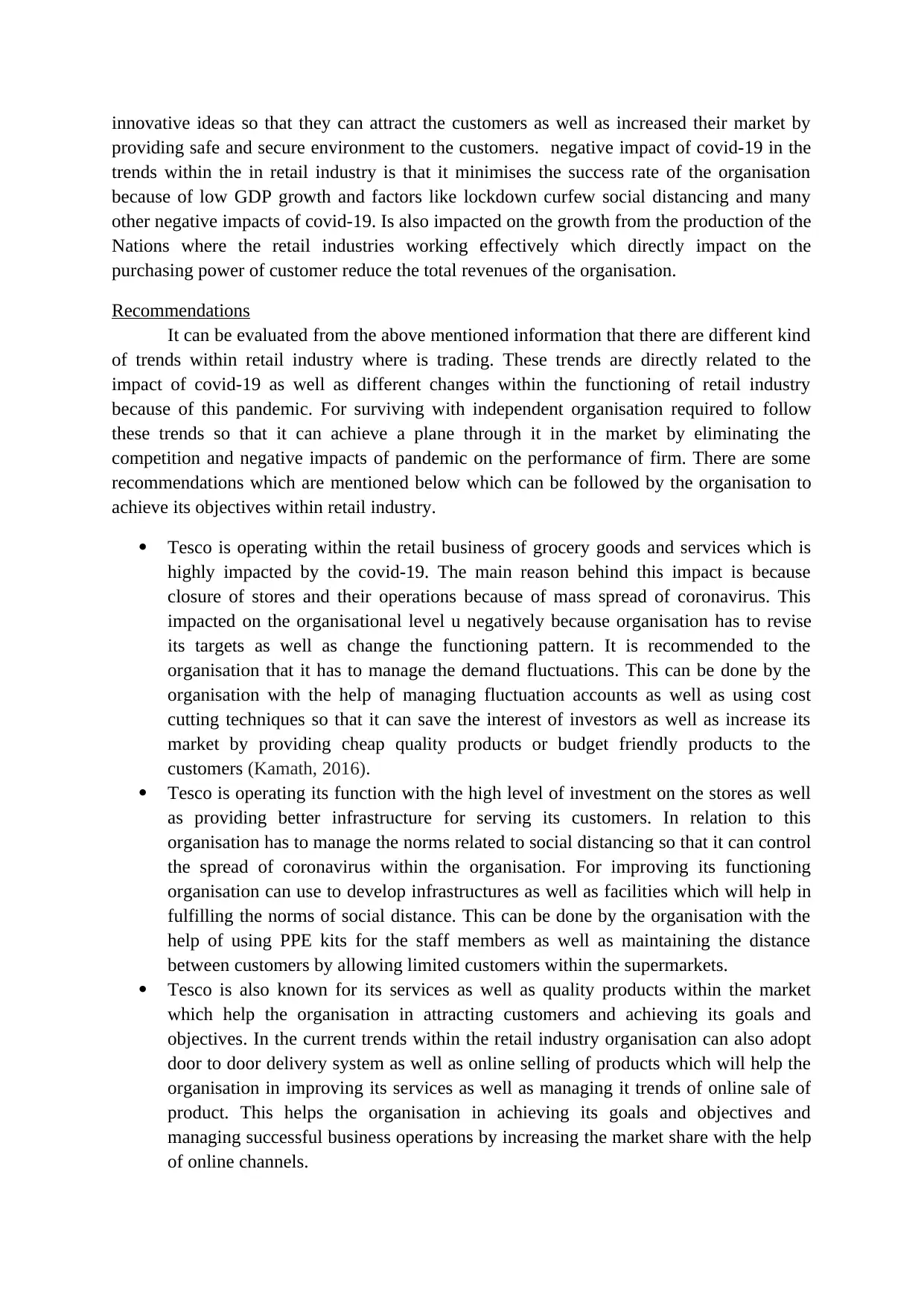
innovative ideas so that they can attract the customers as well as increased their market by
providing safe and secure environment to the customers. negative impact of covid-19 in the
trends within the in retail industry is that it minimises the success rate of the organisation
because of low GDP growth and factors like lockdown curfew social distancing and many
other negative impacts of covid-19. Is also impacted on the growth from the production of the
Nations where the retail industries working effectively which directly impact on the
purchasing power of customer reduce the total revenues of the organisation.
Recommendations
It can be evaluated from the above mentioned information that there are different kind
of trends within retail industry where is trading. These trends are directly related to the
impact of covid-19 as well as different changes within the functioning of retail industry
because of this pandemic. For surviving with independent organisation required to follow
these trends so that it can achieve a plane through it in the market by eliminating the
competition and negative impacts of pandemic on the performance of firm. There are some
recommendations which are mentioned below which can be followed by the organisation to
achieve its objectives within retail industry.
Tesco is operating within the retail business of grocery goods and services which is
highly impacted by the covid-19. The main reason behind this impact is because
closure of stores and their operations because of mass spread of coronavirus. This
impacted on the organisational level u negatively because organisation has to revise
its targets as well as change the functioning pattern. It is recommended to the
organisation that it has to manage the demand fluctuations. This can be done by the
organisation with the help of managing fluctuation accounts as well as using cost
cutting techniques so that it can save the interest of investors as well as increase its
market by providing cheap quality products or budget friendly products to the
customers (Kamath, 2016).
Tesco is operating its function with the high level of investment on the stores as well
as providing better infrastructure for serving its customers. In relation to this
organisation has to manage the norms related to social distancing so that it can control
the spread of coronavirus within the organisation. For improving its functioning
organisation can use to develop infrastructures as well as facilities which will help in
fulfilling the norms of social distance. This can be done by the organisation with the
help of using PPE kits for the staff members as well as maintaining the distance
between customers by allowing limited customers within the supermarkets.
Tesco is also known for its services as well as quality products within the market
which help the organisation in attracting customers and achieving its goals and
objectives. In the current trends within the retail industry organisation can also adopt
door to door delivery system as well as online selling of products which will help the
organisation in improving its services as well as managing it trends of online sale of
product. This helps the organisation in achieving its goals and objectives and
managing successful business operations by increasing the market share with the help
of online channels.
providing safe and secure environment to the customers. negative impact of covid-19 in the
trends within the in retail industry is that it minimises the success rate of the organisation
because of low GDP growth and factors like lockdown curfew social distancing and many
other negative impacts of covid-19. Is also impacted on the growth from the production of the
Nations where the retail industries working effectively which directly impact on the
purchasing power of customer reduce the total revenues of the organisation.
Recommendations
It can be evaluated from the above mentioned information that there are different kind
of trends within retail industry where is trading. These trends are directly related to the
impact of covid-19 as well as different changes within the functioning of retail industry
because of this pandemic. For surviving with independent organisation required to follow
these trends so that it can achieve a plane through it in the market by eliminating the
competition and negative impacts of pandemic on the performance of firm. There are some
recommendations which are mentioned below which can be followed by the organisation to
achieve its objectives within retail industry.
Tesco is operating within the retail business of grocery goods and services which is
highly impacted by the covid-19. The main reason behind this impact is because
closure of stores and their operations because of mass spread of coronavirus. This
impacted on the organisational level u negatively because organisation has to revise
its targets as well as change the functioning pattern. It is recommended to the
organisation that it has to manage the demand fluctuations. This can be done by the
organisation with the help of managing fluctuation accounts as well as using cost
cutting techniques so that it can save the interest of investors as well as increase its
market by providing cheap quality products or budget friendly products to the
customers (Kamath, 2016).
Tesco is operating its function with the high level of investment on the stores as well
as providing better infrastructure for serving its customers. In relation to this
organisation has to manage the norms related to social distancing so that it can control
the spread of coronavirus within the organisation. For improving its functioning
organisation can use to develop infrastructures as well as facilities which will help in
fulfilling the norms of social distance. This can be done by the organisation with the
help of using PPE kits for the staff members as well as maintaining the distance
between customers by allowing limited customers within the supermarkets.
Tesco is also known for its services as well as quality products within the market
which help the organisation in attracting customers and achieving its goals and
objectives. In the current trends within the retail industry organisation can also adopt
door to door delivery system as well as online selling of products which will help the
organisation in improving its services as well as managing it trends of online sale of
product. This helps the organisation in achieving its goals and objectives and
managing successful business operations by increasing the market share with the help
of online channels.
⊘ This is a preview!⊘
Do you want full access?
Subscribe today to unlock all pages.

Trusted by 1+ million students worldwide
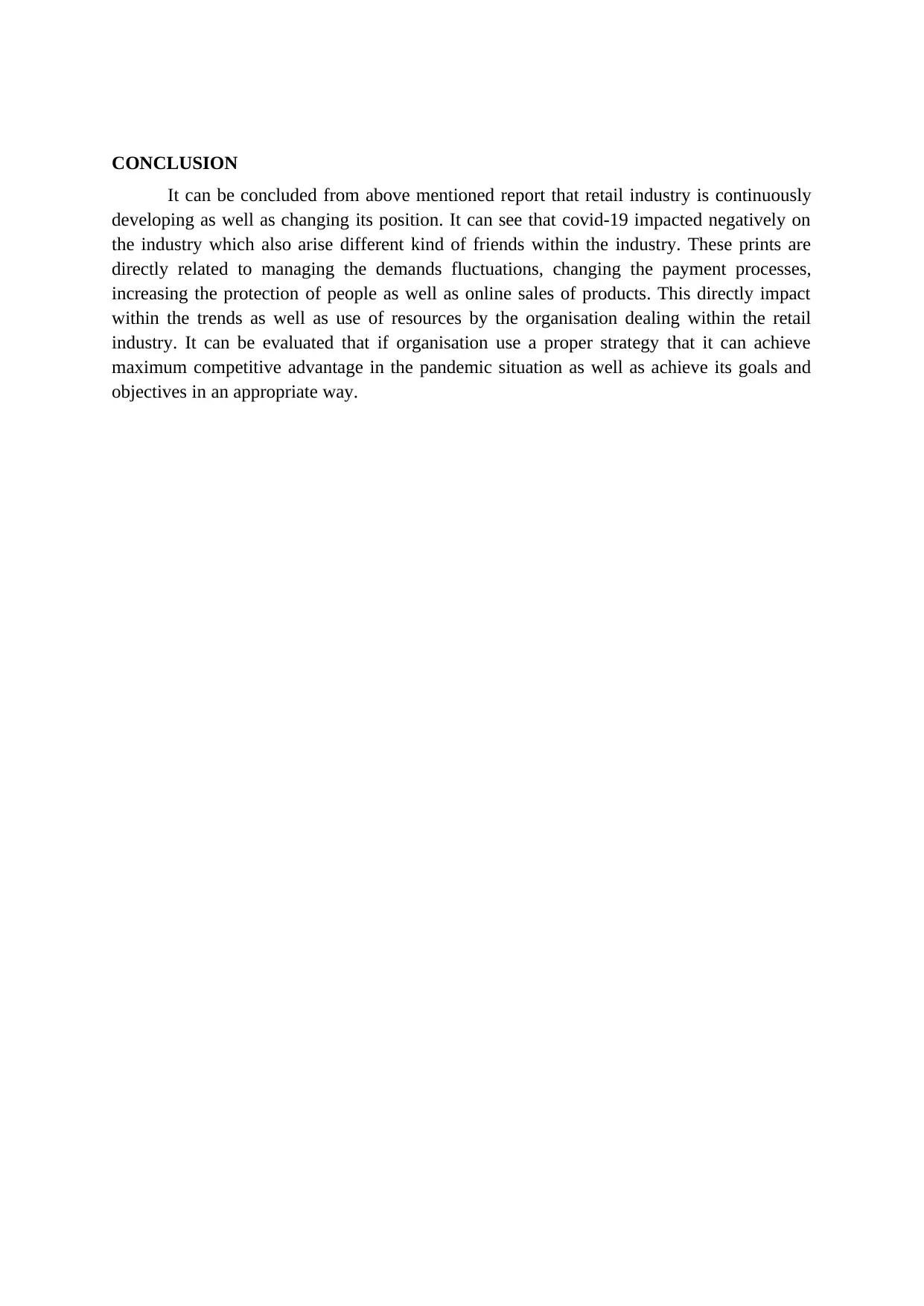
CONCLUSION
It can be concluded from above mentioned report that retail industry is continuously
developing as well as changing its position. It can see that covid-19 impacted negatively on
the industry which also arise different kind of friends within the industry. These prints are
directly related to managing the demands fluctuations, changing the payment processes,
increasing the protection of people as well as online sales of products. This directly impact
within the trends as well as use of resources by the organisation dealing within the retail
industry. It can be evaluated that if organisation use a proper strategy that it can achieve
maximum competitive advantage in the pandemic situation as well as achieve its goals and
objectives in an appropriate way.
It can be concluded from above mentioned report that retail industry is continuously
developing as well as changing its position. It can see that covid-19 impacted negatively on
the industry which also arise different kind of friends within the industry. These prints are
directly related to managing the demands fluctuations, changing the payment processes,
increasing the protection of people as well as online sales of products. This directly impact
within the trends as well as use of resources by the organisation dealing within the retail
industry. It can be evaluated that if organisation use a proper strategy that it can achieve
maximum competitive advantage in the pandemic situation as well as achieve its goals and
objectives in an appropriate way.
Paraphrase This Document
Need a fresh take? Get an instant paraphrase of this document with our AI Paraphraser
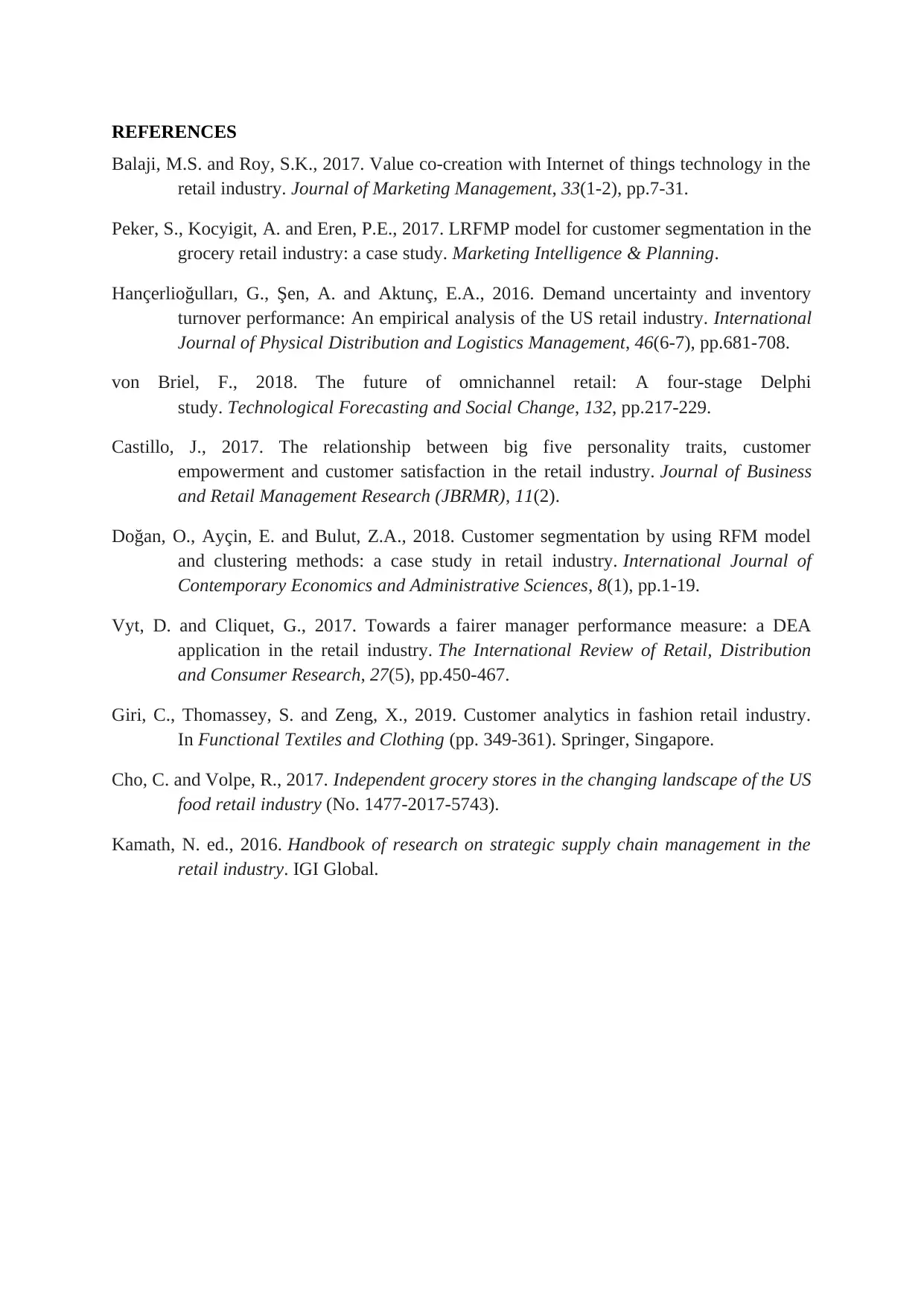
REFERENCES
Balaji, M.S. and Roy, S.K., 2017. Value co-creation with Internet of things technology in the
retail industry. Journal of Marketing Management, 33(1-2), pp.7-31.
Peker, S., Kocyigit, A. and Eren, P.E., 2017. LRFMP model for customer segmentation in the
grocery retail industry: a case study. Marketing Intelligence & Planning.
Hançerlioğulları, G., Şen, A. and Aktunç, E.A., 2016. Demand uncertainty and inventory
turnover performance: An empirical analysis of the US retail industry. International
Journal of Physical Distribution and Logistics Management, 46(6-7), pp.681-708.
von Briel, F., 2018. The future of omnichannel retail: A four-stage Delphi
study. Technological Forecasting and Social Change, 132, pp.217-229.
Castillo, J., 2017. The relationship between big five personality traits, customer
empowerment and customer satisfaction in the retail industry. Journal of Business
and Retail Management Research (JBRMR), 11(2).
Doğan, O., Ayçin, E. and Bulut, Z.A., 2018. Customer segmentation by using RFM model
and clustering methods: a case study in retail industry. International Journal of
Contemporary Economics and Administrative Sciences, 8(1), pp.1-19.
Vyt, D. and Cliquet, G., 2017. Towards a fairer manager performance measure: a DEA
application in the retail industry. The International Review of Retail, Distribution
and Consumer Research, 27(5), pp.450-467.
Giri, C., Thomassey, S. and Zeng, X., 2019. Customer analytics in fashion retail industry.
In Functional Textiles and Clothing (pp. 349-361). Springer, Singapore.
Cho, C. and Volpe, R., 2017. Independent grocery stores in the changing landscape of the US
food retail industry (No. 1477-2017-5743).
Kamath, N. ed., 2016. Handbook of research on strategic supply chain management in the
retail industry. IGI Global.
Balaji, M.S. and Roy, S.K., 2017. Value co-creation with Internet of things technology in the
retail industry. Journal of Marketing Management, 33(1-2), pp.7-31.
Peker, S., Kocyigit, A. and Eren, P.E., 2017. LRFMP model for customer segmentation in the
grocery retail industry: a case study. Marketing Intelligence & Planning.
Hançerlioğulları, G., Şen, A. and Aktunç, E.A., 2016. Demand uncertainty and inventory
turnover performance: An empirical analysis of the US retail industry. International
Journal of Physical Distribution and Logistics Management, 46(6-7), pp.681-708.
von Briel, F., 2018. The future of omnichannel retail: A four-stage Delphi
study. Technological Forecasting and Social Change, 132, pp.217-229.
Castillo, J., 2017. The relationship between big five personality traits, customer
empowerment and customer satisfaction in the retail industry. Journal of Business
and Retail Management Research (JBRMR), 11(2).
Doğan, O., Ayçin, E. and Bulut, Z.A., 2018. Customer segmentation by using RFM model
and clustering methods: a case study in retail industry. International Journal of
Contemporary Economics and Administrative Sciences, 8(1), pp.1-19.
Vyt, D. and Cliquet, G., 2017. Towards a fairer manager performance measure: a DEA
application in the retail industry. The International Review of Retail, Distribution
and Consumer Research, 27(5), pp.450-467.
Giri, C., Thomassey, S. and Zeng, X., 2019. Customer analytics in fashion retail industry.
In Functional Textiles and Clothing (pp. 349-361). Springer, Singapore.
Cho, C. and Volpe, R., 2017. Independent grocery stores in the changing landscape of the US
food retail industry (No. 1477-2017-5743).
Kamath, N. ed., 2016. Handbook of research on strategic supply chain management in the
retail industry. IGI Global.
1 out of 8
Related Documents
Your All-in-One AI-Powered Toolkit for Academic Success.
+13062052269
info@desklib.com
Available 24*7 on WhatsApp / Email
![[object Object]](/_next/static/media/star-bottom.7253800d.svg)
Unlock your academic potential
Copyright © 2020–2025 A2Z Services. All Rights Reserved. Developed and managed by ZUCOL.



